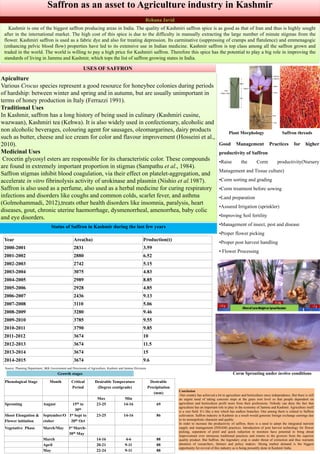saffron
- 1. Saffron as an asset to Agriculture industry in Kashmir Kashmir is one of the biggest saffron producing areas in India. The quality of Kashmiri saffron spice is as good as that of Iran and thus is highly sought after in the international market. The high cost of this spice is due to the difficulty in manually extracting the large number of minute stigmas from the flower. Kashmiri saffron is used as a fabric dye and also for treating depression. Its carminative (suppressing of cramps and flatulence) and emmenagogic (enhancing pelvic blood flow) properties have led to its extensive use in Indian medicine. Kashmir saffron is top class among all the saffron grown and traded in the world. The world is willing to pay a high price for Kashmiri saffron. Therefore this spice has the potential to play a big role in improving the standards of living in Jammu and Kashmir, which tops the list of saffron growing states in India. Rehana Javid Apiculture Various Crocus species represent a good resource for honeybee colonies during periods of hardship: between winter and spring and in autumn, but are usually unimportant in terms of honey production in Italy (Ferrazzi 1991). Traditional Uses In Kashmir, saffron has a long history of being used in culinary (Kashmiri cusine, wazwaan), Kashmiri tea (Kehwa). It is also widely used in confectionary, alcoholic and non alcoholic beverages, colouring agent for sausages, oleomargarines, dairy products such as butter, cheese and ice cream for color and flavour improvement (Hosseini et al., 2010). Medicinal Uses Crocetin glycosyl esters are responsible for its characteristic color. These compounds are found in extremely important proportion in stigmas (Sampathu et al., 1984). Saffron stigmas inhibit blood coagulation, via their effect on platelet-aggregation, and accelerate in vitro fibrinolysis activity of urokinase and plasmin (Nishio et al.1987). Saffron is also used as a perfume, also used as a herbal medicine for curing respiratory infections and disorders like coughs and common colds, scarlet fever, and asthma (Golmohammadi, 2012),treats other health disorders like insomnia, paralysis, heart diseases, gout, chronic uterine haemorrhage, dysmenorrheal, amenorrhea, baby colic and eye disorders. USES OF SAFFRON Status of Saffron in Kashmir during the last few years Year Area(ha) Production(t) 2000-2001 2831 3.59 2001-2002 2880 6.52 2002-2003 2742 5.15 2003-2004 3075 4.83 2004-2005 2989 8.85 2005-2006 2928 4.85 2006-2007 2436 9.13 2007-2008 3110 5.06 2008-2009 3280 9.46 2009-2010 3785 9.55 2010-2011 3790 9.85 2011-2012 3674 10 2012-2013 3674 11.5 2013-2014 3674 15 2014-2015 3674 9.6 Source: Planning Department, J&K Government and Directorate of Agriculture, Kashmir and Jammu Divisions Plant Morphology Saffron threads Good Management Practices for higher productivity of Saffron •Raise the Corm productivity(Nursery Management and Tissue culture) •Corm sorting and grading •Corm treatment before sowing •Land preparation •Assured Irrigation (sprinkler) •Improving Soil fertility •Management of insect, pest and disease •Proper flower picking •Proper post harvest handling • Flower Processing Corm Sprouting under invitro conditionsGrowth stages Phenological Stage Month Critical Period Desirable Temperature (Degree centigrade) Desirable Precipitation (mm) Max Min Sprouting August 15th to 30th 23-25 14-16 69 Shoot Elongation & Flower initiation September/O ctober Ist Sept to 20th Oct 23-25 14-16 86 Vegetative Phase March/May Ist March- 30th May March 14-16 4-6 88 April 20-21 9-11 88 May 22-24 9-11 88 Conclusion Our country has achieved a lot in agriculture and horticulture since independence. But there is still an urgent need of taking concrete steps at the grass root level so that people dependent on agriculture and horticulture profit more from their professions. Nobody can deny the fact that agriculture has an important role to play in the economy of Jammu and Kashmir. Agriculture itself is a vast field. It’s like a tree which has endless branches. One among them is related to Saffron cultivation. Saffron industry in Kashmir as a result would generate foreign exchange earnings due to its monopolistic character and quality In order to increase the productivity of saffron, there is a need to adopt the integrated nutrient supply and management (INSAM) practices. Introduction of post harvest technology for flower picking, separation of pistil and quick reduction in moisture have potential to bring about improvement over strenuous traditional practices and returns to the growers from the superior quality product. But Saffron, the legendary crop is under threat of extinction and thus warrants attention of researchers, farmers and policy makers. Strong market demand is the biggest opportunity for revival of this industry as is being presently done in Kashmir India.
